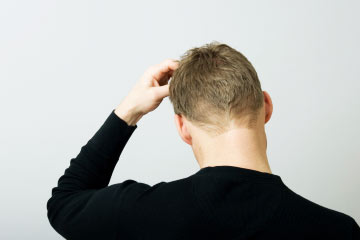How to use tea tree oil for dandruff

If you’re struggling with dandruff, tea tree oil might be the natural solution you've been looking for. Most cases of dandruff are caused by a specific yeast-like fungus that lives on the scalp. This fungus feeds on your scalp’s natural oils (called sebum) and triggers irritation, which leads to flaking skin — those pesky white flakes on your clothes.
The most common dandruff treatments are medicated shampoos you’ll find at the supermarket or pharmacy. While some can be effective, many contain strong chemicals that may irritate sensitive skin.
Luckily, natural alternatives like tea tree oil offer a gentler approach, without sacrificing results. In fact, a good tea tree oil shampoo can be just as — or even more — effective than many over-the-counter products.
How to use tea tree oil for dandruff
Research has shown that using a shampoo containing 5% tea tree oil can significantly reduce dandruff, especially for mild to moderate cases. The results usually become noticeable after about four weeks of consistent use.
If you can’t find a ready-made tea tree oil shampoo, making your own is easy:
- Simply add 2.5 teaspoons of tea tree oil to every 8 ounces (approx. 240ml) of your favourite shampoo.
- If you prefer measuring in drops, add about 30 drops per ounce of shampoo.
An easy rule of thumb: one drop of tea tree oil per millilitre of shampoo. This creates roughly a 5% tea tree oil solution — the same concentration shown to be effective in studies.
Use your tea tree oil shampoo daily. With consistent use, many people find their dandruff noticeably reduced — or even completely gone — after about four weeks.
The Australian Tea Tree Industry Association recommends varying concentrations of tea tree oil depending on your scalp concerns, so it's worth experimenting to find what works best for you.
What actually causes dandruff?
Dandruff isn’t just dry skin — it can be triggered by several factors. According to the Mayo Clinic, common causes of dandruff include:
- Dry skin
- Irritated, oily skin (seborrheic dermatitis) — flaky, yellow or white scales often appear on the scalp, eyebrows, sides of the nose, or behind the ears
- Infrequent shampooing, allowing oil and dead skin to build up
- Malassezia, a common yeast-like fungus that can irritate the scalp
- Contact dermatitis, or sensitivity to hair care products — especially those with harsh chemicals like paraphenylenediamine
Who’s most likely to get dandruff?
While dandruff can affect anyone, certain factors increase your risk:
- Age — It’s more common in teens and adults under middle age
- Gender — Men tend to be more prone, possibly due to male hormones
- Oily scalp and hair — Excess oil feeds the fungus that causes dandruff
- Poor diet — Your skin and scalp health depend on good nutrition
- Underlying health issues — Conditions like Parkinson’s, HIV, or a weakened immune system can make dandruff more likely
A quick fun fact…
Interestingly, the yeast that causes dandruff produces a byproduct called oleic acid, a healthy unsaturated fat often used in food production. But before you get excited — this doesn’t mean dandruff flakes belong anywhere near your breakfast bowl! The irritation caused by the yeast penetrating the skin is what leads to the visible flakes, not the byproduct itself.
The bottom line
Dandruff can be frustrating, but it’s manageable — and tea tree oil offers a natural, effective solution. With regular use of a tea tree oil shampoo, you can help soothe an itchy scalp, reduce flakes, and enjoy healthier hair and skin — all without harsh chemicals.
Disclaimer
The content on this website is not intended to be a substitute for professional medical advice, diagnosis, or treatment. Always seek medical advice for any questions regarding a medical condition.

